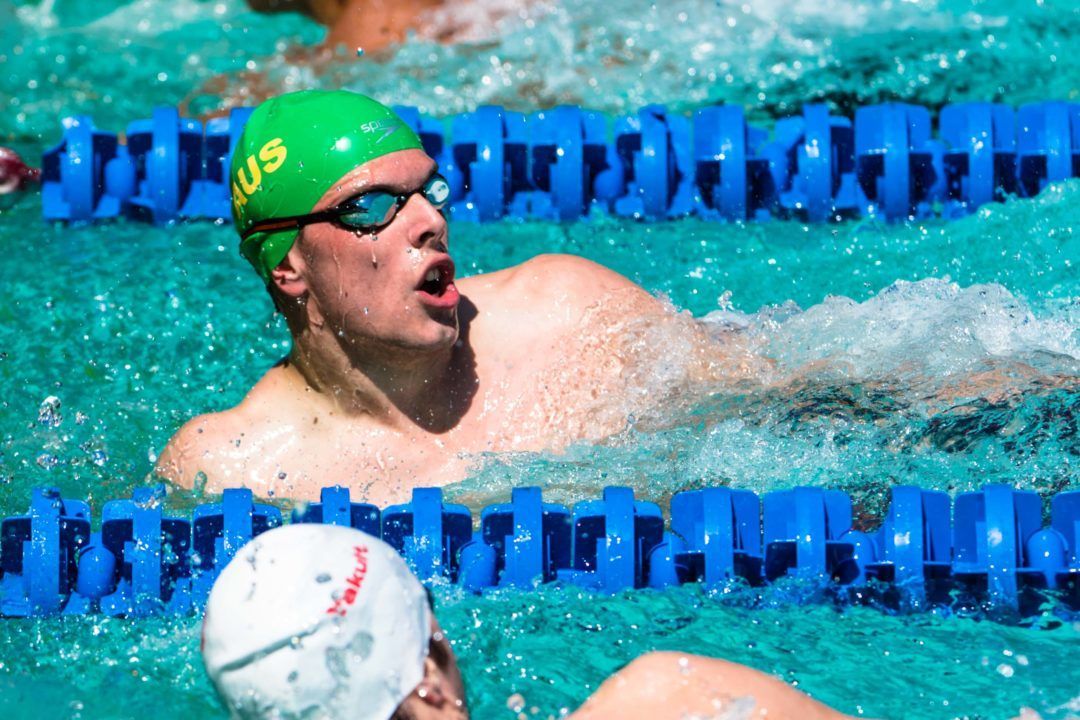TritonWear and SwimSwam bring you the best in swimming race analysis for the 2018 Commonwealth Games. With the power of TritonWear, you can access 12+ metrics for all athletes simultaneously, display the results in real-time to unlimited screens on deck, and review later in an easy to use interface for monitoring progress and identifying trends over time. See all Tritonwear Race Analysis here.
Ian Thorpe’s 200m freestyle Games record remained untouched, but Australia’s Kyle Chalmers
swam an impressive race.
Chalmers had an inconspicuous start. His speed and split were average on the first lap, but fell
behind heading into the 100m. This placed him in seventh off the halfway turn. It was on the
back half of the race where he turned things around, dropping his split by almost a full second
on the third 50.
Overall, Chalmers employed a strategy of higher DPS and stroke index with a slower stroke
rate. The second lap saw a drastic decrease in his stroke rate, and though he simultaneously
lengthened his strokes, he generated one of the slowest speeds on this lap.
This appeared to be his way of saving energy and gearing up for the finish as he suddenly
increased his stroke rate at the halfway point, without losing much of his stroke efficiency. He
did pull shorter, less efficient strokes in the final lap. But with a final burst of energy, he also
managed to speed up his strokes at an even faster rate, offsetting the efficiency loss, leading
him to outtouch Horton to the wall.
On the lanes beside him, Scotland’s Duncan Scott and England’s James Guy had a tight match
going on. Scott and Guy’s speed and stroking metrics (DPS, stroke index, and stroke rate) were
not far off from each other. But while Scott had better stroke efficiency, Guy pulled his strokes at
a faster rate. His faster strokes gave him the lead over Scott for most of the distance, but he
was not able to hold Scott off to the end.
Scott swam at a faster speed than Guy after the halfway turn, and while Guy managed to pull a
higher DPS on the third lap, he was not able to maintain it the entire 100m. He rushed through
his strokes off the final turn, increasing his stroke rate but also losing a great amount of stroke
efficiency. This was all it took for Scott to beat him for a podium finish by a tenth of a second.
Key Takeaways
Chalmer’s performance demonstrates the importance of race strategy and stroke efficiency.
Chalmers generally had high stroke index numbers, indicating good stroke efficiency. Though
he took his time with each pull, the distance he produced with each stroke ensured he didn’t lag
too far behind despite his slow stroke rate. It was just enough for him to properly pace himself
so that he could speed up his strokes and charge through the second half of the race. Going out
too fast in the beginning could have fatigued him into losing his advantage. At the same time,
less efficient strokes at the rate he pulled would have put him too far behind to pull ahead in the
last lap.
To dive into the numbers of each athlete yourself, use the interactive board below to see exactly
how they performed across all metrics.
Stay tuned for more race analysis!
VISIT THE TRITONWEAR HQ
LIKE TRITONWEAR ON FACEBOOK
FOLLOW TRITONWEAR ON TWITTER
FOLLOW TRITONWEAR ON INSTAGRAM
Swimming analysis is courtesy of Tritonwear, a SwimSwam partner.


Nice write-up, quick suggestion: you mention Thorpe’s record in the teaser but then fail to say what the record time is. That would be interesting information to include!
Where is the video of the swim
Very impressive swim after second heart surgery. Amazing swim to Kyle Chalmers.